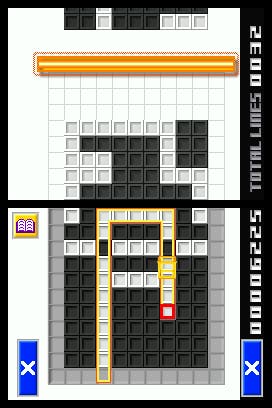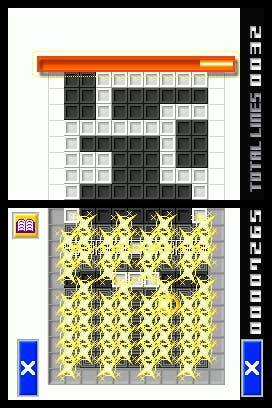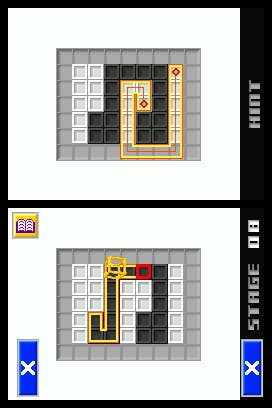Polarium
Continuing the puzzle gaming renaissance in style.
2005 appears to be the year the puzzle genre finally awoke from its depressingly prolonged coma and thrust itself back into frontline Top 40 action. You'd swear you can smell frazzling synapses when you enter the Eurogamer HQ these days. In one corner you've got Tom busy clocking up multi-million Time Attack scores on Zoo Keeper and muttering about getting Meteos on import, while I put my worn-out copy of the stupidly under-appreciated It's Mr Pants to one side to try out the latest challenger, Nintendo's Polarium. At this rate we'll be submitting our Mensa applications and buying bigger hats to disguise the fact that our brains are bursting out of our skulls. We're nothing if not modest.
Despite having outsized hat-wearers, we still have no idea what Polarium is supposed to mean. Dictionary.com wonders if we meant solarium, while the next best suggestion Larium is some kind of anti-malarial drug. Maybe it's what Polar Bears take when they go on tropical adventures. Who the hell knows? Suggestions please.
Not every puzzle game in life is black and white

Back to the saner and altogether more fathomable topic of what Polarium's about, we're on sturdier ground. Being designed from the ground up for the touch screen marvel that is the DS it's far from being a mere novelty to use the stylus. It's an obligation, and one you'll appreciate the more you play the game and the faster your reactions need to be. Playable in two quite distinct ways, the overall gameplay principles apply identically to both in that it's all about clearing those darned dastardly blocks again. Yep, another game to send you off to bed with shapes in front of your eyes.
In many senses Polarium has several classic puzzle gaming principles that make it feel immediately familiar and easy to pick up, but yet somehow manages to introduce a few unique twists to still make it a somewhat unique and intriguing, beguiling prospect. As per usual it's a grid-based affair with black or white tiles laid on top of it and as such it's up to you to clear them as efficiently as possible. No real change there, then.
In what amounts to the regular 'action' mode of Polarium, the 'Challenge' is simply to delete as many 'lines' of tiles as possible before the screen fills up. Very Tetris. But wait! The actual fundamental process of selecting and clearing tiles is uniquely DS-style, with the stylus control an obligatory part of making the game work at all; the game would be slow, fiddly, cumbersome and about a hundred times less playable without the touch sensitive input.
White lines blow awaaaaaay

The path to clearing tiles is in itself exceptionally simple but clever in the manner of all good ideas. The key is to clear each line horizontally; thus in, the most basic example, if one row of black tiles has a white tile interrupting it, simply tap the white tile to confirm your turn and flip the tile black, complete the row and cause the line to vanish. If only things stayed that simple.
But playing Polarium by just tapping individual tiles their opposite colour one by one would quickly result in a Game Over screen. Very quickly you'll learn to drag the stylus swiftly over large areas of the screen in order to create chain reactions that may not seem obvious to begin with, but soon become a familiar part of the process of ridding the screen efficiently.
An often important part of this stylus dragging process is to utilise the grey border around the play area, which allows you to effectively duck in and out of the active part of the grid. This potentially allows you to avoid tiles you don't want to touch and also lets you skirt around the perimeter and re-enter on a part of the grid that allows you to maybe pull off a massive chain reaction and clear the entire lower part of the screen in one fell swoop. But it's only one block wide, and you can't go over your lines once you've drawn them.
You big tease

But while this is a massively challenging and addictive part of Polarium's charm, it's by no means our favourite element of the package. Tom puts its failings down to what he calls "a lack of friendly intuition" on the DS' part. In other words, he doesn't like the way that your rapid strokes sometimes cover the wrong block halfway along, requiring you to either abandon the line by hitting one of the grid-side X icons or to painstakingly snake your way backward and get the line going on the correct path. Of course precision is important, but easier difficulty levels that auto-correct your stylus' weaving might have worked, perhaps penalising you for such transgressions by limiting your points reward for that line. Or by limiting your overall scoring rate, and forcing you to move onto higher difficulty levels that demand more precision to challenge for the big numbers. You know, like Zoo Keeper. But without some sort of concession to the bounciness of life, the stylus goes astray once in a while, it's too easy to run out of headroom, you start to get tired of seeing the first few minutes of complete-able blocks over and over again before losing in the same place, and eventually your interest in Challenge wanes. Tom, get off my keyboard; clicking point to point with your stylus is the way forward, as observers in the thread have noted, allowing the game to fill in the gaps for you.
Anyaway. Enough about Challenge. Asuch, the game's Puzzle mode is where the real long-term, satisfying brain-teasing comes to the fore, and simultaneously acts as a great way to hone your skills without the accompanying pressure of being hassled by endlessly descending lines. The trick in Puzzle is to work out how to clear each of the 100 play fields in one continuous line. What you're presented with initially are some very simple and easy to fathom grids that anyone could work out, but after about twenty or thirty levels in you'll sit and pour over them for ages, often getting them immediately, other times awaiting the CPU's help in knowing where you should start and finish. But once you work out how best to flip all the tiles in the prescribed manner it's an immensely satisfying feeling and with so many levels to work through it's a game that'll last well beyond many titles on the DS. Even when you're done you can create your own puzzles with the accompanying level editor, or import some of your friends' creations. It's a title with a great potential longevity.
And happily Nintendo has been wise enough to make it a single cartridge multiplayer game that also offers ten puzzle levels as a 'demo' for other DS owners to try out at their leisure. With a cart each, though, you're able to face off in a tricksy multiplayer experience that essentially works a little like Tetris in multiplayer, in that whatever you manage to remove from your screen goes onto the opposing players, with the winner being the one who manages to clear their screen first. It's a frantic affair with the most proficient pattern-spotters usually winning out, but perhaps one that could have been fleshed out with a few more modes. As nice an addition as it is, it works best alone.
Retro futurism
Perhaps the biggest challenge for Nintendo is managing to convince its audience to give the game a second glance. With some of the most basic visuals seen since the days of the ZX81 and mind-numbingly uninspired audio it's not going to woo gamers looking for the quick thrill that other eye-candy laden DS titles will. Hopefully the prospect of another compelling, involving and satisfying puzzle title which could only work on the DS will provide the hook and convince one or two sceptical gamers of its slow-burn appeal. Okay, it's not the best handheld puzzle game we've played this year, but it still deserves praise for being one of the DS' hidden gems. Satisfaction guaranteed.

